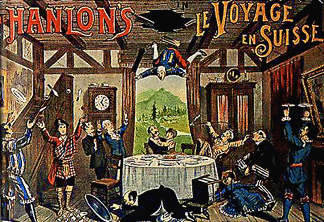


Part II
(Reproduced with permission from Clowns: A Panoramic History by John H. Towsen)



A Trip to Switzerland
"I do not think that a combination of the wildest ideas of the author of Through the Looking Glass and Baron Munchausen, with a dash of Sir Boyle Roche's most highly-flavoured Hibernian topsy-turvydums and a flavouring of Jules Verne, could give a more confusing effect to the mental condition of the ordinary every-day human being than has A Trip to Switzerland," a London critic wrote in 1880 of the Hanlon-Lees' most famous production. "I must confess"' he continued, "that the ordinary playgoing equilibrium which I generally assume and maintain was shaken to its roots."
A Trip to Switzerland was perhaps one of the most significant productions in the history of popular entertainment, for in it a wide range of circus techniques, stage music, and dazzling scenic trickwork was incorporated into a dramatic context and performed by a group of the world's most talented acrobats, jugglers, and clowns. It enjoyed long-running engagements in Paris in 1879 - where it enthralled Emile Zola - in London in 1880, and in New York City in 1881.
The story line of A Trip to Switzerland was a mere vehicle for the unique talents of the Hanlon-Lees. Its farcical plot and punning dialogue (by Blum and Toché) was commissioned by the Théâtre des Variétés specifically for the Hanlon-Lees. It was translated and adapted for the London stage by a Mr. Reece and adapted anew for American audiences by Henry Pettitt.
The first act of this "Parisian absurdity" opens (in the English version) in a small town on the Devonshire coast, where the virtuous Finsbury Parker is about to wed his beloved Julia. The joyous occasion is interrupted by the arrival of an evil spirit in the person of Matthew Popperton. In the name of Julia's legal guardian, Schwindelwitz, he forbids the ceremony and produces a letter ordering her to accompany him back to Schwindelwitz's hotel in Switzerland. Furthermore, the letter stipulates that, should the middle-aged Popperton propose to young Julia en route, she must accept, or dread the consequences.
A despondent Finsbury is cheered up by the arrival of an old friend, the eccentric baronet, Sir George Golightly, whose help he enlists in saving Julia. Golightly also promises the aid of his wild young nephews, Ned and Harry (Edward and George Hanlon), soon due back from the University of Bonn, accompanied by their French tutor, Monsieur La Chose (Agoust). Arriving on the same coach, as it turns out, are Popperton's two servants, Bob and John (Frederick and William Hanlon).
Everything is set for the entrance of the Hanlon-Lees. Halfway across the stage, their coach is violently capsized, breaking into hundreds of pieces and splattering the passengers and their limbs aII over the place. But before the horror can sink in, the Hanlon-Lees come cascading down from the top of the carriage, landing in comfortable seated positions, facing the footlights in a faultless line, still calmly smoking their cigars, with one of the brothers on another's shoulders.
Before the plot can proceed any further, the new visitors plunder the local tavern, with Popperton's servants adding to the chaos by playing all kinds of pranks on their fellow travelers. Especially praised was a marvelous piece of sleight of hand in which the servants hand a wine bottle back and forth with such dexterity that it is physically impossible for its owner to detect its whereabouts as it passes directly under his nose. When it is finally returned to him, the contents have disappeared.
The first act ends with Julia, Popperton, and his two servants embarking for Switzerland. In hot pursuit are Parker, Monsieur La Chose, Golightly, and Golightly's two nephews - all devoted to making Popperton's trip to Switzerland and his sojourn there so miserable that he will consent to give up Julia. And in the grand tradition of comic servants, Popperton's own two valets also join forces with Parker and company.
When the curtain rises for the second act, the audience sees a cross- section of a Pullman sleeping car. Underneath are rotating wheels, giving the illusion of a train traveling at full speed. In the center compartment are Popperton and Julia, while elsewhere in the car are Parker and his many friends, intent on preventing Popperton from broaching the subject of marriage. In the original French version,however, Popperton and Julia were already wed and now had to be stopped from consummating the marriage, perhaps a more comical situation, but one that the English adapter apparently found too coarse for British tastes.
The ensuing scene in the train compartment becomes a comic nightmare for Popperton. Each time he is about to pop the question, he is interrupted by the appearance of one of Parker's allies - sometimes through the door, sometimes through the ceiling. The servants pound on the compartment wall, telling a very quiet Popperton not to make so much noise, while Sir George plays "Don't Make a Noise" on a huge cornet. Disguised as train conductors and later as customs inspectors, they find dozens of excuses to intrude. Knowing Popperton's hatred of tobacco, they smoke constantly. "Their instantaneous appearances in all places at once," marveled one critic, "make one inclined to disbelieve one's eyes." One of Popperton's servants falls to the tracks and appears to get run over by the onrushing train, only to reappear on the roof. This sustained frenzy culminates in a scene strikingly similar to that of the overcrowded stateroom in the Marx Brothers film, A Night at the Opera (1935), as all the passengers on the train pile into Popperton's tiny compartment.
Eventually the anti-Popperton forces run out of stalling tactics. "With a daring eccentricity peculiar to English baronets" (as one viewer put it), Golightly decides to blow up the train. A guard is bribed and a few moments later the train actually splits in two on stage, sending the terrified passengers flying into the air before landing them safely in nearby trees.
The third and final act takes place at the Rigi Kulm, the Swiss hotel run by Julia's guardian, Schwindelwitz. Parker and friends appear, now disguised as Alpine tourists and hotel waiters, still hoping to dissuade Popperton by whatever means necessary. A diner party for the couple is disrupted as the waiters drop plates and dishes and scald the guests with hot soup and coffee. Total confusion reigns once the waiters begin juggling with dishes and food, as in the Dinner at Maxim's juggling act. Oranges and loaves of bread fly through the air, plates are both spun and juggled, and Agoust at one point juggles three eggs, a knife, and a plate. When one of the waiters goes into an upstairs room, where dynamite is stored, he accidentally ignites it, which blows a hole in the floor and sends him crashing down onto the dinner table.
There follows a brilliant drunk scene in which Popperton's servants experience great difficulty in trying to light a candle while drinking, with one of them even sticking the lit candle, rather than bottle, down the throat of the other.
Soon these same servants are pursued by a gendarme (played by Agoust), who hopes to arrest them for their complicity in the destruction of the train. A hide-and-seek chase scene over tables boxes, wardrobes, staircases, and the fireplace proves the servants to be far too clever for the policeman. "It is the point of the chase," explained a reviewer, "that though the two are always hovering round their would-be captor, he could not once have detected their presence. He opens the door of a cupboard, to which he has tracked one of the men, who is there indeed, but [who] slips quietly through the legs of his adversary. Some of the leaps and tricks tax the courage as well as the agility of these excellent mimes, but the absence of perceptible effort is always a source of pleasure to the spectator."
Much of this trickwork, such as a closet with double doors that totally baffles the gendarme, was clearly derived from stage magic. Especially startling was the decapitation effect used in this same scene. When the gendarme climbs into a box, one of the servants sits on the lid, apparently slicing straight through his neck. (Some twenty years earlier, William Hanlon had been the first person to introduce to the United States a decapitation effect based on mirrors.)
After this brilliant scene, the Hanlon-Lees return to the main story line. Further wreckage of the hotel, and exposure of Schwindelwitz and Popperton as old swindlers who were merely interested in Julia's fortune, enable Finsbury Parker to win back bride, and everything ends happily.
In terms of split-second timing and perfect technique, A Trip to Switzerland was clearly extraordinary. But the clowning of the Hanlon Lees was said to have been every bit a match for their acrobatics. "An athlete might accomplish much of the rougher and more practical fun," commented another London critic, "but only humourists could succeed in the lighter and more delicate touches of mute comedy. Gifted with most expressive faces, the Hanlons create laughter at every look and movement, and at last give us pantomime with a meaning in it... The term of 'clowning' ceases to be a reproach when it is brought to such a pitch of excellence as this."

